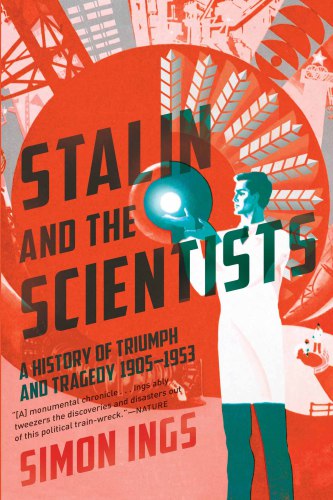
Stalin and the Scientists
A History of Triumph and Tragedy, 1905–1953
کتاب های مرتبط
- اطلاعات
- نقد و بررسی
- دیدگاه کاربران
نقد و بررسی

December 19, 2016
English novelist and science writer Ings (The Eye: A Natural History) takes an expansive look at scientific life in the Soviet Union from the waning years of the Russian Empire to Stalin’s death. Faced with grave challenges in the immediate aftermath of the 1917 Bolshevik revolution, and driven by a Marxist philosophy that envisioned a future universal science that encompassed politics and society, Soviet elites endeavored to make the Soviet Union “the world’s first scientifically run state.” These leaders embarked on an ambitious struggle to place science in “the service of society” and bring vast practical and humanitarian benefits to mankind. The pursuit of science was soon trumped by politics, ideology, and the whims of leaders, as Stalin’s “cult of personality expanded into the natural realm.” Ings sympathetically details the experiences of scientists who lived a complex, precarious, and harrowing existence as shifts in prevailing ideological winds exposed many to severe repression, including purges, arrests, and executions. The stories and anecdotes of individual scientists provide narrative bridges throughout the book, as Ings ably documents the challenges, failures, and achievements of Soviet science during this period in such areas as psychology, physiology, genetics, neuroscience, and cybernetics. Though he can be long-winded, Ings engagingly fuses history, science, and storytelling.

November 15, 2016
Picking through a minefield of Soviet utopia and paranoia.All sciences would coalesce into one, and this science would usher the new socialist being--so believed the Soviet state in its promulgation and censoring of brilliant Russian scientists from the establishment of the Bolshevik order onward. British novelist and science writer Ings (A Natural History of Seeing: The Art and Science of Vision, 2008, etc.) builds from the utopian vision of lofty scientism advocated by Lenin and Alexander Bogdanov in 1904 to the surviving crop of nervous scientists under Stalin, who were busy trying to make thermonuclear weapons in the late 1940s. The first hurdle for true scientists--e.g., the mineralogist and geochemist Vladimir Vernadsky--was the crippling material conditions in Russia, a situation caused largely by successive famines in the early 1920s and the rampant backbiting in the Academy of Sciences and other official agencies that effectively monitored and restricted intellectuals. The new order was in a hurry to bring on a "revolutionary generation," and above all, the Bolsheviks needed engineers, removing specialists from universities and ensconcing them in well-appointed institutes that became hives of bureaucratic and competitive disgruntlement. After Lenin died, Stalin moved to industrialize the country by fiat and quickly "rattle through the stages by which true communism might be achieved." Ings moves somewhat unevenly through these stages of increased authoritarianism, beginning with Stalin's Great Purge, which sacrificed many brilliant scientists and intellectuals such as Nikolai Vavilov, an internationally revered botanist whose fall was startling ("We shall go to the pyre," he predicted). "Pure science" did not exist, and many scientists were galvanized in Stalin's "Plan for the Great Transformation of Nature," a grand deforestation and dam-building project to make even the natural world yield to the plan. A provocative and increasingly chilling work that shows how scientists in the nascent Soviet Union were sacrificed to the Soviet dream of building the ideal state.
COPYRIGHT(2016) Kirkus Reviews, ALL RIGHTS RESERVED.

November 1, 2016
In examining the historical development of Soviet science before and after the Russian Revolution of 1917, novelist and science writer Ings (The Eye) focuses on the many ideological controversies that shaped the discipline during that era. With only a few introductory chapters on the transition from the Tsars to the Bolshevik Revolution, general readers may not be adequately prepared to understand the complexities given prominence in the book. There is substantial coverage of Joseph Stalin's personal and political interference in the development of science in the Soviet Union as well as the resulting controversies relating to genetics, biology, chemistry, and physics--in which Stalin established himself as the ultimate authority, often at the expense of many lives. VERDICT With an excellent bibliography, this book is recommended for sophisticated readers who appreciate the intricacies of Russian and Soviet political and scientific controversies and the dangers they brought to a society in turmoil. Those new to the subject might do well to consider Ethan Pollock's Stalin and the Soviet Science Wars or works by science historian Loren Graham.--Amy Lewontin, Northeastern Univ. Lib., Boston
Copyright 2016 School Library Journal, LLC Used with permission.

January 1, 2017
During the Stalin era, Soviet propaganda and sympathetic Westerners touted the objective science of Marxism and the belief that as socialism evolved, freedom and creativity would be unleashed. In reality, of course, Stalin had created a closed system that stifled any ideas that deviated from the official dogma. Ings, a novelist and science writer, shows that this was particularly evident in the regime's relationship with scientific researchers, since the Soviet Union was supposedly dedicated to transforming human nature itself, elevating science to a semidivine status supported by lavish funding. Those whose activities and conclusions aligned with the truth as declared by the party were praised as Soviet heroes and richly rewarded. But those scientists who insisted upon independently following where their research efforts led them were often shunned, shamed, and persecuted. Ings' account follows the careers of some of these admirable men as well as knaves like Trofim Lysenko, a quack biologist and one of Stalin's favorites. This is an engrossing and disturbing cautionary tale illustrating the dangers that arise when rigid state ideology collides with scientific reality.(Reprinted with permission of Booklist, copyright 2017, American Library Association.)

























دیدگاه کاربران